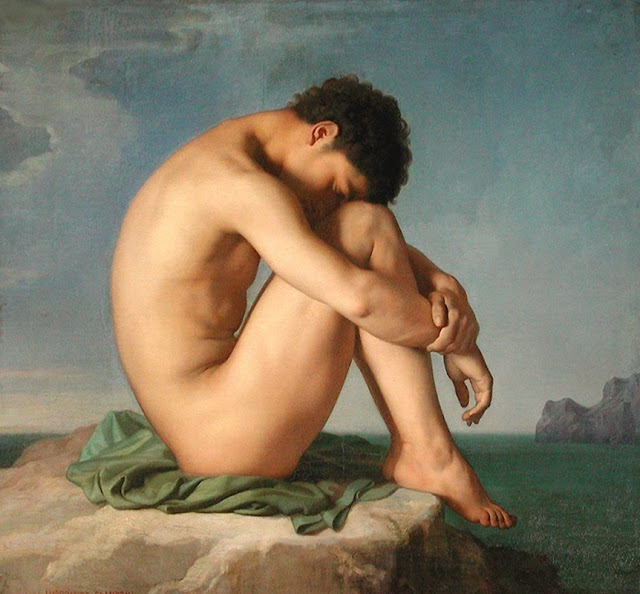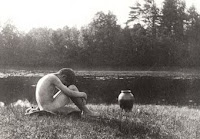 I knew this picture so I went searching in my inventory and found this one that I used sometime ago in medieval house where I lived at a Sim called San Miguel.
I knew this picture so I went searching in my inventory and found this one that I used sometime ago in medieval house where I lived at a Sim called San Miguel.
(Update 5 december 2011. Read the Comment )
I do not know who is the artist of this work and also not know what is the original name of it.
But searching on the internet taught me that it was not the original.
The original is made by Jean Hippolyte Flandrin (1809 - 1864) Lyon - France
Study (Young Male Nude Seated beside the Sea) (French: Jeune Homme nu assis au bord de la mer, figure d'étude) is a painting by Hippolyte Flandrin executed between 1835 and 1836. Flandrin had won France's Prix de Rome in 1832, a bursary which provided the winner with a trip to Rome to concentrate on their vocation. There, Flandrin produced this study, which he sent back to Paris in 1837, in fulfillment of the bursary's requirements for the student to submit works in the tradition of various genres. In 1857, Napoleon III purchased the painting, which is now in the collection of Paris's Louvre.

 The painting gained attention among contemporary French art critics, and remains one of Flandrin's best-known works, despite being produced relatively early in his career. The subject is an unidentified youth, an "ephebe" (a Greek word for an adolescent age group or a social status reserved for that age in Antiquity), who sits nude on a rock with his arms wrapped around his legs and his head resting on his knees, eyes closed. There is a sea in the background, and no distinguishable landmarks locate the figure. The enigmatic scene provides no explanation for the figure's pose: Théophile Gautier (1811–1872) commented that the young man could be shipwrecked on a deserted island, or be a shepherd who has lost his flock. Ultimately, any explanation for this scene is left to the imagination, leading to comparisons with Surrealist art in the twentieth century.
The painting gained attention among contemporary French art critics, and remains one of Flandrin's best-known works, despite being produced relatively early in his career. The subject is an unidentified youth, an "ephebe" (a Greek word for an adolescent age group or a social status reserved for that age in Antiquity), who sits nude on a rock with his arms wrapped around his legs and his head resting on his knees, eyes closed. There is a sea in the background, and no distinguishable landmarks locate the figure. The enigmatic scene provides no explanation for the figure's pose: Théophile Gautier (1811–1872) commented that the young man could be shipwrecked on a deserted island, or be a shepherd who has lost his flock. Ultimately, any explanation for this scene is left to the imagination, leading to comparisons with Surrealist art in the twentieth century.
Vital to the painting's spread were reproductions based on an 1887 engraving by Jean-Baptiste Danguin that was commissioned by the state. As awareness of the work grew, the painting became an icon of homosexual culture in the 20th century, although the work would not have been intended to evoke such a theme. The scene is intimate, yet the figure is, according to one author, "self-absorbed, passive, alienated—undoubtedly contribut[ing] to the persistence of certain homophobic clichés." Photographers Marcel Moore and Claude Cahun adopted the pose in a photograph of the lesbian Cahun, c. 1911. The painting was similarly evoked in early twentieth-century art photography by F. Holland Day and Wilhelm von Gloeden, and later by Robert Mapplethorpe.


The painting and more particularly the pose of the young man has become an icon of homoeroticism, John Coulthart has compiled a collection of its various representations.
The Official Site for Art and Design
by John Coulthart.
and the pose archive




4 comments:
Hey chris, cool site!
The picture above, with the supermanclothes, comes from Worth1000, a photoshopcontest site.http://www.worth1000.com/entries/236748/a-day-off
Thank you, Apuh. For the compliment and for the update.
Great site and great photos
Thank you, Carl. I will follow your blog and you're exploring of Second Life.
Ooh, I deleted the repeats. I thought one time is enough. **smiles**
Post a Comment